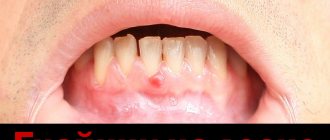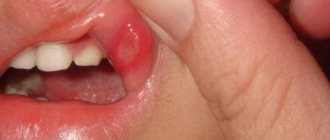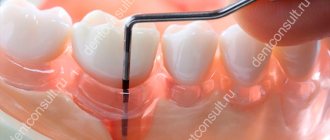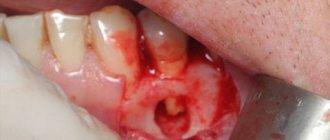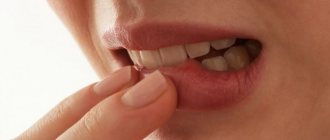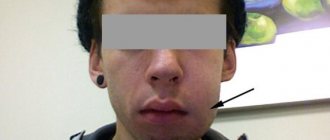Possible complications
- Cellulitis - with this disease, a large part of the lower jaw swells, and the smell and taste of purulent contents appears in the oral cavity. Acute phlegmon is characterized by a sharp rise in temperature and deterioration in well-being. Inflammation affects connective and fatty tissue. If not treated in a timely manner, the abscess spreads to adjacent healthy areas. What to do in this situation? Since phlegmon develops rapidly, it must be treated with antibiotics. In case of advanced sepsis, surgical intervention and treatment in a hospital are performed.
- Osteomyelitis - from the affected gum, a purulent process moves into the nearby bone tissue. This disease is dangerous to human health and life. Severe manifestations of pathology lead to deformation of the jaw bone and tissue destruction. Acute osteomyelitis is characterized by fever, pain in the oral cavity when eating and opening the mouth. After visiting a doctor, the cavity in the gum is cleaned and drained. Antibiotics can be applied directly to the wound or taken orally. Constant antiseptic measures are carried out.
- Hematoma - when a blood clot occurs in the gum, treatment is carried out only by a surgeon. He will clean the hole with a special instrument, apply antiseptics and prescribe a course of antimicrobial drugs. Drainage is required to remove mucus and blood.
Why is it important to see a doctor if symptoms of complications begin? This can prevent health risks and speed up the patient's recovery process.
Plastic surgery on gums
Plastic surgery today is actively used in many areas of medicine, including dentistry. It is aimed at changing the shape of the soft mucous membranes of the oral cavity - that is, the gums. It is a mistake to believe that problems with gums can only be expressed in their inflammation and bleeding. Gums can change their shape after prolonged periodontitis or periodontal disease; sometimes their shape needs to be adjusted during dental prosthetics. Plastic surgery is also recommended if the labial frenulum is too short or too long.
Plastic surgery on the gums: indications
- short or too strong frenulum of the lip or tongue,
- gum recession: mucous membranes decrease in volume, exposing the roots of the teeth,
- voluminous periodontal pockets, when the gums peel off from the surface of the teeth,
- inflammation of the gums during teething,
- correction of gum level during prosthetics,
- change in the shape of the gums after prolonged inflammation and treatment of periodontitis, periodontal disease.
Plastic surgery on the gums: contraindications
Although operations on the gums are fairly simple plastic surgeries, they are still surgical. Therefore, the general condition of the body is of great importance: general contraindications include diabetes mellitus, weak immunity, and diseases of the cardiovascular system.
Plastic surgery on gums: types
- gingivoplasty: the general name for all operations, the essence of which is to create an aesthetic appearance of the gums. Many patients are faced with the formation of so-called gingival or periodontal pockets - the gum peels off from the tooth, forming cavities up to several millimeters deep, where food debris accumulates and bacteria multiply. You can perform curettage (professional cleaning of cavities), but the gums will lose their aesthetics. There is also the opposite situation - the gums, on the contrary, rise too much above the teeth, exposing their tops. Therefore, creating an aesthetic appearance of the gums is the goal of gingivoplasty,
- gingivectomy: a type of gingivoplasty. This operation is performed to quickly correct the gingival margin when eliminating gum pockets - that is, part of the excess gum is simply cut off and given a new shape,
- vestibuloplasty: also a type of gingivoplasty, but the technology is the opposite of gingivectomy. Due to advancing age or periodontal disease, the gums may shrink in size and unsightly expose the roots of the teeth. The goal of vestibuloplasty is to return the gum to its previous volume and normal appearance, which is achieved by cutting it and then building it up,
- excision of the hood: carried out in cases of difficult teething, usually wisdom teeth. Often their growth is accompanied by pain and inflammation of the gums as a result of insufficient hygiene and inaccessible places for cleansing. As a result, the gum becomes very inflamed and increases in size - a kind of tubercle (“hood”) is formed, where food particles become clogged, causing even greater inflammation. Excision of this tubercle and removal of part of the gum allows you to eliminate the problem and ensure normal growth of the tooth. In addition, a lip frenulum that is too long or too short leads to a violation of the aesthetics of the gums: this is a thin mucous membrane that ideally connects the middle of the inner part of the lips with the middle of the upper or lower gums in the area of the front teeth. If it is too short, the gums gradually decrease in size, resulting in the roots of the teeth being exposed. If it is long, then it also does not visually decorate your smile too much.
There is also a similar tongue frenulum - but it, as a rule, only leads to a lack of tongue mobility and rarely affects the condition of the gums. To avoid all problems, the frenulum must be trimmed - as a rule, such an operation is performed in childhood. The thin mucosa is cut and, if necessary, a healing bandage is applied to it. The operation can also be performed in adults.
How is gum grafting performed?
In general, all plastic surgeries on gums are performed using the following technology:
- the dentist assesses the condition of the gums and administers an anesthetic,
- part of the gum is excised, or incisions are made to transplant it to another position,
- the gum is sutured,
- medications are prescribed for rapid tissue regeneration after surgery.
Depending on the extent of the surgical intervention, tissue restoration occurs on average in 1-2 weeks. After plastic surgery on the gums, it is advisable to avoid hard foods for a while and limit conversations. It is also recommended to reduce physical activity and in no case should you forget about oral hygiene, especially if there are sutures on the gums, where bacteria and microbes can accumulate.
| Price: 1,800 rub. | |
| Gum vestibuloplasty (flap surgery) using a surgical laser 1 jaw | Price: 12,000 rub. |
| Plastic surgery of the frenulum of the lip and tongue | Price: 5,000 rub. |
| Surgical enlargement of the coronal part of 1 tooth with osteotomy | Price: 3,000 rub. |
| Flap surgery 1 jaw incl. ultrasonic treatment with antiseptic | Price: 15,000 rub. |
Gum excision
Excess gum tissue or tissue that cannot be restored is cut off:
- In case of violation of the eruption of molars - their retention, pericoronitis.
- If there are pathological formations at the root apex - cysts or granulomas.
- If an abnormality in root development is detected during tooth extraction.
- If the crown is destroyed - to ensure the removal of all fragments.
- For inflammation leading to non-viability of the gums - periodontal disease, gingivitis, periodontitis.
Removing tissue promotes better gum restoration.
How to remove the drainage yourself?
For many patients, even a small latex strip interferes with eating, talking and creates a lot of inconvenience. It is not surprising that they want to get the drain out as soon as possible. Is it worth doing it yourself or is it better to have the procedure done in a doctor's office?
During its installation, the dentist usually warns that this strip may fall out on its own or can be removed at home. But it will be safer to go to the clinic for help from a specialist who will do it correctly.
We invite you to familiarize yourself with Diseases of the oral cavity and tongue: types of pathologies and methods of their treatment
If you decide to remove the drainage yourself, you will need:
- Wash your hands thoroughly and disinfect them.
- You can rinse your mouth with some antiseptic solution to disinfect the surfaces around the wound.
- Stand in front of a mirror, grab the edge of the strip with your fingers and slightly pull it outward.
Many people are concerned about the question of whether it hurts to remove drainage from the gums. This procedure is simple, but can cause pain and bleeding. Doctors recommend additional rinsing of the treated area for several days after this in order to disinfect the surface and speed up tissue healing.
A doctor is consulted if bleeding does not stop after removing the latex strip for two hours. This may indicate that you have hit a large vessel or that some complication has arisen.
For what purpose and how is the gum trimmed for a crown?
Installation of crowns is a method of correcting the dentition.
However, there are situations when it is necessary to correct not only the teeth, but also the gums. This is due to both aesthetic and technical reasons: sometimes, due to the irregular shape of the gums, the doctor cannot reliably fix the prosthesis. How gums are trimmed for a crown - read below. The operation may be prescribed in the following cases:
- “Short teeth” due to too wide a band of gum tissue.
- An uneven edge that looks unsightly.
- The gap between the gum and tooth (pocket) is too large.
- Inflammatory processes (periodontitis, gingivitis), which serve as an obstacle to fixation of the crown.
- Damage to gum tissue with the risk of spreading to neighboring areas.
There are a number of indications for the operation.
In these cases, tissue must be removed not only for aesthetic reasons, but also due to the fact that the gap between the teeth and gums is a place where bacteria accumulate, which can lead to the development of inflammatory processes.
The operation is not performed if there are contraindications , which include:
- decompensated diabetes mellitus;
- blood diseases;
- cardiovascular diseases in the stage of decompensation;
- infectious diseases in the acute stage;
- immune pathologies.
In addition, surgery is not indicated if the inflammation has already affected the bone tissue.
A week
At this point, the granulation mass is replaced by connective tissue. The new epithelium is still very thin and vulnerable, so all hygiene procedures should be carried out carefully, without damaging the wound. It is still not worth chewing on the side on which the tooth was located. Parts of the clot still remain inside the hole, but externally the wound is already covered with epithelium.
A week after removal, the first regeneration phenomena in the bone tissue are noticeable: thin bone beams are built, which will then become the basis for bone overgrowth at the site of the removed tooth root.
Cheek tumor
Hello. After filling three canals of the 16th tooth. A temporary filling was placed. The tooth ached all day. By evening my cheek was swollen. In the morning, my cheek was swollen even more. I came to the dentist. They cut the gum and installed drainage. They said that the pus did not have time to collect. washed. And they told me to come in a day.
Dentist's answer:
Hello! After the incision, the swelling does not subside immediately, but only within 3-5 days, because the incision, in itself, is an additional injury. It may be that in your situation the incision will not bring a good result. Often, to relieve inflammation, it is necessary to re-treat the canals.
What if the tube falls out?
If the drain falls out, the patient should immediately consult a dentist. Returning the drainage system to the gum on its own can lead to wound infection and serious complications.
The doctor will examine the oral cavity and assess the situation. The absence of swelling after the drainage system falls out indicates the end of the process of outflow of pus - in this case, its re-installation is not required. If the swelling does not subside, the dentist will install the system into the gum again. Reasons that can cause a drainage tube to fall out include:
- improper brushing technique;
- excessive number or intensity of rinses;
- errors in the process of fixing the tube.
Special cases
Normally, the wound heals in a few weeks, but it happens that this process takes longer. This happens in the following cases:
- wisdom tooth removal;
- dissection of the gums during surgery;
- bone injury;
- socket infection.
In these cases, the epithelium may appear only after a month and a half. If the wound was stitched, then the stitches were removed, the drainage was removed, and the wound was washed with medications, then regeneration would take even longer and be more difficult. It should also be remembered that gums in children and young people heal much faster than in older people.
Rest after surgery
The first few hours after drainage installation are the most critical. During the procedure, the dental surgeon needs to administer anesthesia, cut the gum, pump out the pus, and perform an antiseptic treatment of the cavity. The patient is weakened by the infectious process and the operation itself. Therefore, upon returning home, it is recommended:
- sleep for a couple of hours;
- take painkillers and anti-inflammatory drugs after the anesthesia wears off - Nimesil, Nise, Nurofen, Ketanol;
- do not drink or eat for several hours.
Causes
The main cause of edema is a deep mechanical effect on the tissue. The tooth is always removed from the root, but with the use of anesthesia the patient does not experience pain. After extraction, the next day, when sensitivity is restored, the gums swell (sometimes, as with), which can affect the entire face. Such a change in tissue is a forced reaction of the body to an injury or the beginning of the development of complications.
We suggest you familiarize yourself with the most severe freezing during tooth extraction
Extensive tissue swelling is often caused by sutures placed after sawing out a destroyed molar. If no purulent abscess occurs during the healing process, it will subside within five days.
When the swelling itches, it can be caused by a reaction to the injected anesthetic. In most cases, it is caused by novocaine, since its active components have a pronounced allergic effect. Immediately after tooth extraction, swelling quickly spreads to adjacent healthy areas.
The cause of delayed edema, which occurs after a few days, can be. It develops due to the loss of a barrier blood clot that protects the socket from the entry of food and liquid elements. Usually its elimination is associated with mechanical action, after which the inflammatory process begins.
If the operation was too traumatic, development may occur. The extent of the swelling will depend on its size.
The tumor develops as a result of a hematoma. Usually, the accumulation of blood in the tissue is caused by careless damage to the vessel. If the dentist touches a vessel, internal pain begins.
Another reason for the development of edema and its persistence for a long period is non-compliance with the dentist’s general recommendations necessary during the rehabilitation period.
Contraindications
Why and in what cases is the gum opened to install drainage?
- appearance, that is, when the patient’s cheek is swollen, which indicates a pathological process called periostitis;
- in order to accelerate tissue healing after severe cases of tooth extraction;
- at ;
- when it is necessary to periodically inject medications into the wound, which is also done using drainage;
- if pathogenic formations are detected in the root zone of the tooth, for example, or.
In rare cases, this procedure will not work:
- if the patient has problems with blood clotting, then doctors try to avoid any incisions if possible;
- If you have an allergic reaction to the anesthetics administered, complications may also arise.
But in any case, the procedure for removing purulent or bloody discharge must be carried out, since without this it is almost impossible to cure most diseases. One way or another, the doctor must find a way to do this in order to prevent sepsis.
An incision in the gum and installation of drainage is performed according to indications and only by a specialist. This procedure also has contraindications:
- Use with caution in patients with bleeding disorders.
- Before inserting the rubber strip or tube, the doctor must inject anesthesia so that the patient does not experience pain when the gum is cut. If you are allergic to certain medications, the dentist must select a medication that will effectively relieve pain and will not cause an unpredictable reaction in the body.
The procedure for performing gum surgery
Regardless of the type of operation, the technology for its implementation comes down to the following steps:
- conducting an examination of the condition of the gums, general preparation of the oral cavity: removal of carious formations, plaque and tartar from the teeth, as well as from under the gums. This is important because before surgery it is necessary to remove all pathological formations from underneath it. Therefore, gum plastic surgery is often combined with an operation called gum curettage.
- anesthetic is administered - the operation is performed under local anesthesia,
- part of the gum is removed (an incision is made using a scalpel or laser), or it is incised and moved to a new location. If acute tissue recession is observed, then part of the mucous membrane is transplanted - while it is borrowed from another area,
- stitches are placed.
After the operation, drug treatment is necessarily prescribed to speed up the process of restoration of damaged tissue. The patient also needs to rinse the mouth, make applications (compresses on the gums) and baths with antibacterial and wound-healing drugs.
Types of plastic surgery
Our clinic performs all types of plastic surgery on the gums, the general name of which is gingivoplasty. The type of plastic surgery is selected depending on the indications and the initial state of the mucosa, as well as the goal to be achieved:
- Gingivectomy: involves cutting off part of the overgrown gum in the presence of large gum pockets. The mucous membrane is given a new shape by applying sutures,
- vestibuloplasty: an operation that is the exact opposite of gingivectomy. With this method, the volume of the gum is restored during its atrophy, that is, recession. The operation involves cutting the gum at the base, after which the flap is moved to a new location. A graft taken from areas where aesthetics is not too important can also be used as a material for extension.
- excision of the hood: an operation that is performed when the gum volume increases during teething (as a rule, this problem occurs in adult patients with the growth of “wisdom teeth”). Food particles often get trapped under the hood, which leads to acute inflammation. Excision of the hood and removal of part of the gum tissue helps the tooth grow normally and relieves the patient from pain,
- Trimming the frenulum of the lip and tongue: The lips, tongue and gums are connected by a thin film called the frenulum. It can be very short, which leads to tension and gum recession, or, on the contrary, too massive - its large size overlaps part of the front teeth. In order to improve aesthetics, the shape of this bridle can be adjusted - for this it is slightly incised or partially trimmed.
Tissue regeneration or restoration takes about 1-2 weeks, depending on the complexity of the operation. After gum surgery, it is necessary to abstain from solid foods for some period and not to injure the mucous membranes with too cold or hot foods. It is also worth minimizing physical activity.
How many days does the swelling usually last?
It all depends on the patient’s age category, the body’s ability to tolerate injury, the complexity of extraction and individual characteristics. In most cases, after tooth extraction, swelling begins to subside on the third day.
How long does swelling last in a normal situation without the occurrence of diseases during severe surgical interventions? When the entire base of the tooth is destroyed and the crown is affected, the swelling is pronounced and lasts up to 7 days. The cause of the tumor in this case is cut tissue and detachment of the mucous membrane for better capture of the root.
How long does it take for the swelling to subside if a wisdom tooth was removed and suppuration began? Infection requires cleaning of the canals. Due to constant manipulation of the gums, swelling can persist for up to two weeks.
We suggest you familiarize yourself with the Taste of iodine in the mouth: causes: in women, after meals, in the morning
Sometimes the inflammation spreads to the eye area, which can cause decreased vision. Edema is accompanied by additional symptoms in the form of fever and deterioration in well-being.
Flux and great swelling. What to do after a gum incision?
My son has a lot of swelling and, of course, gumboil. Yesterday we went to the doctor, they opened his gum. We started taking the antibiotic doxycycline and rinsed with chlorhexidine, as the doctor who made the incision said.
But I want to ask you: the swelling is very large, almost up to the eye, what to do in this case? And how will the swelling go away? At least tell me approximately. And what else can you do?
The doctor made a relieving incision to relieve the exacerbation. Subsequently, the cause of the swelling must be determined and treated. The swelling should go away within 3-4 days. See your doctor again for an examination.
Contact phone number
Comments and reviews 32
My daughter (6 years old) had swollen gums, so we went to the dentist. The doctor removed the filling and the pus drained out. She prescribed rinsing the tooth cavity and Sulfadimethoxin tablets. We do everything and drink, but the tooth hurts and the gums are still swollen. On what day should the swelling on the gums subside, or should I go to the doctor again? Answer
An examination and a targeted x-ray are required. It is possible that the tooth cannot be treated and will need to be removed or the treatment plan adjusted. Everything is individual. Swelling of the gums may subside for 2 days or more. It is better to consult in person with a pediatric dentist. Answer
General dentist
The tooth is broken, only slightly sticking out, the cheek is swollen, i.e. gumboil has appeared. I assume that they will cut the gum. Tell me, how painful is it to cut the gum? I know that with gumboil, painkilling injections do not help much. And what actions will follow next? I'm very afraid. Answer
At the moment, a large number of painkillers have appeared; it is not at all necessary that there will be severe pain. In any case, the longer you delay a visit to a specialist, the more difficult and painful the manipulations will be. It will be necessary to remove the causative tooth, open the purulent-necrotic process, create drainage for the outflow of contents, and a course of antibiotic therapy and other medications will be prescribed. Answer
General dentist
Help me decide if I should panic. The tooth was destroyed, it was rooted, it began to bother me, and the gums underneath it were swollen. I came to the hospital, the roots were removed, an incision was made, and a drain was installed. After a couple of hours, my cheek became swollen, and after two days the swelling subsided. Nothing hurts. But the gums were densely swollen and remained, even more than before removal, the drainage has not yet been removed. Is this the norm or not? Answer
Some swelling after removal is normal for some time; it is important to follow the recommendations of your doctor and arrive on time for your appointments. Maintain oral hygiene, rinse your mouth with an antiseptic (miramestin, chlorhixedine) after eating, unless there are contraindications to these drugs. Answer
General dentist
Hello, I went to a specialist with flux and acute pain, as a result of which two teeth were removed and the gums were opened, drainage was not installed (5 days ago). I feel a dull pain, the gums are swollen, there is a white coating in the sockets, is this normal? Answer
It is worth contacting a specialist again for an examination. The described picture is characteristic of a relapse (i.e., resumption of the inflammatory process). The presence of plaque on the tongue, swelling and pain indicates the presence of a purulent-inflammatory process. Answer
General dentist
Good afternoon Yesterday I was diagnosed with a flux, but no drainage was installed. The cheek tumor appeared in the morning and is accompanied by a dull pain and a temperature of 37.3. I went to the doctor, he looked at it and answered that this is how it should be. Is it so? How long? Why didn't they install drainage? Answer
Without a clinical examination it is impossible to make a clear judgment. Drainage may not be installed if the created outflow is sufficient. Typically, a low-grade fever may persist for several days, but swelling should decrease. Answer
Yesterday I was diagnosed with a flux, but no drainage was installed. The next morning, my cheek became swollen, accompanied by pain and a temperature of 37.3. Today I went to the doctor again. The doctor replied that it should be so. I take antibiotics. Why didn't the doctor install drainage, how long will the swelling and pain last? Answer
Drainage is installed according to indications, based on the initial clinical picture. Pain and swelling after opening the flux can last up to 7 days. You should follow all recommendations of your dentist. To relieve swelling, you can use antihistamines. Answer
General dentist
Today they cut my gums because I had gumboil. The tooth was not removed, after 1 hour a large amount of clot began to collect under my lip. I would say a very large number. Should it be like this? Answer
It is impossible to judge without a clinical examination. If drainage conditions are created, the exudate leaves the periapical tissue. Answer
General dentist
At the first consultation, the dentist prescribed Cifran 500, took it for 2 days, and the swelling did not go away. I had to open the gum. Another doctor prescribed Amoxicillin and took it for 2 days. What is better to drink now after opening the gumboil? Answer
It is impossible to change antibiotics from one to another without drinking the full course of treatment. Consult in person with a dental surgeon; opening the flux is not enough; it is necessary to eliminate the problem and cure the causative tooth. An antibiotic can be prescribed only after studying the history of life and disease. Answer
General dentist
Today I had surgery on my upper wisdom tooth. They removed the tooth, made an incision, and installed a drainage rubber. An hour after visiting the surgeon, a tumor appeared in the temple area. Within an hour I slept heavily and was barely visible. How does this relate to flux? The tumor did not reach the temple. Answer
Yes, this may be associated with an inflammatory process in the periapical tissues. If there is drainage, the exudate will exit through it. Answer
General dentist
I am treating a difficult tooth. After the gum incision, rinsing was prescribed. I rinsed my mouth with Chlorhexidine immediately after brushing my teeth. The tongue is numb and tingling. The night passed, but so did the feeling. Will this pass? Answer
Yes, the discomfort should go away within two days. Answer
How long does the pain last?
Pain after extraction is normal because the dental nerve is damaged. Pain during the first two to three days is considered a normal situation. During this time, your doctor may recommend pain medications.
After removal of the “eights”, the gums take longer to heal, so pain can be observed for up to a week. This is due to the fact that the “eights” have four roots, each of which has a nerve.
In addition, the wound after wisdom tooth extraction is deeper and larger in area.
The gums take a particularly long time to heal after removing an impacted tooth, since during this operation large incisions are made in the mucous layer, and sometimes they are embedded in the bone. Healing also takes a long time after operations during which cysts were removed under the roots or on the side of the socket.
When will the incision heal?
Patients who are preparing to install a drainage system are always interested in how long it takes for the gums to heal after dissection (see also: how long does it normally take for gums to heal after tooth extraction and how long does it hurt?). On average, 1–2 months after the gum incision, it tightens. Complete tissue restoration can take up to six months. The incision healing process includes several stages:
- formation of a blood clot after surgery;
- maturation of new granulation tissue within 3–4 hours;
- epithelization over 7–10 days;
- wound regeneration 14–21 days after dissection;
- formation and compaction of young bone tissue over 2–4 months;
- fusion of tissue with the jawbone after 5–7 months.
After surgery, dentists give recommendations, adherence to which will promote tissue healing as quickly as possible. The most effective rules include:
- Postoperative diet. Many doctors focus on how long after tooth extraction and dissection of the gum tissue you can eat (we recommend reading: how many hours after tooth extraction can you eat?). Dentists allow you to eat food no earlier than 3-4 hours later. Doctors also talk about the benefits of dietary nutrition during this period.
- Postoperative regimen. Dentists strongly recommend that the patient avoid physical activity, going to the sauna and the gym after the incision has been made. It is also necessary to stop smoking and drinking alcohol.
Treatment options
Periostitis that occurs after dental surgery can be eliminated in two ways:
- Conservative. Antiseptic rinsing of the wound is done, anti-inflammatory drugs and antibiotics are prescribed.
- Surgical. Consists of:
- anesthesia for the operated area;
- cutting the gums, sometimes – detachment of the periosteum with exudate;
- washing out purulent contents after the incision;
- installation of drainage to ensure drainage of pus;
- then antibiotics are prescribed (usually Lincomycin), non-steroidal anti-inflammatory drugs (Nimesil, Ibuprofen), antiseptic oral baths (soda and salt solution);
- removing the drainage when all the pus has drained;
- suturing the edges of the wound.
In difficult cases, flux is treated surgically.
How to rinse your mouth after a gum incision
Rinsing the mouth after surgery is not done immediately, so as not to wash out the blood clot from the wound.
They use pharmaceutical products: chemical and herbal, as well as those prepared at home.
Home Remedies
| Ready-made products | ||
| Chemical | On herbs | |
| Chlorhexidine | Stomatophyte | Infusions: take 1 tbsp. for 1 tbsp. boiling water, leave for 15–30 minutes, strain, cool, add to a volume of 200 ml |
| Miramistin | Maraslavin | Saline or soda-salt solution (1 teaspoon each of soda and salt, preferably sea salt, per 1 cup of water) |
| Furacillin | Rotokan | Light pink solution of potassium permanganate |
In addition to general recommendations, the doctor will advise what to rinse the mouth of a particular patient.
You need to rinse after each meal until swelling and pain disappear. Sometimes the same products are used for applications and lotions on the incision area.
Who had the hood cut off over the wisdom tooth, your comments
It’s better to pull it out, it doesn’t participate in chewing and sooner or later it will start to rot (if it hasn’t already) I recently pulled out both of the top ones - I’m very happy, otherwise they tore all my cheeks.
Last year I had a cut, I asked to have the tooth removed, but the doctor refused and said that the tooth was healthy.
It hurt for a week, I sat on Ketanov all week, rinsed it, applied Metrogid Denta ointment.
It’s better to pull it out, it doesn’t participate in chewing and sooner or later it will start to rot (if it hasn’t already) I recently pulled out both of the top ones - I’m very happy, otherwise they tore all my cheeks.
What will you use to secure bridges in your old age?
they cut it off not so long ago in the fall, the tooth came out a long time ago, but part of it was under the hood, it became quite inflamed, in this case because a pathogenic environment had formed under it, something was constantly clogged
It was done by a dental surgeon in a regular clinic, everything went well and healed quickly, only when the anesthesia wore off I almost lost my ear from the pain, I bought the usual painkillers Ketanov
I took antibiotics as prescribed by the doctor, also anti-allergenic, and also rinsed with Stomatofit, there is a solution in all pharmacies with herbs and alcohol intended just for such cases and inflammation in the oral cavity
the inflammation hurt more than after the operation, so don’t let it get to that point, if you’re worried, consult a doctor immediately
Stages of healing
Immediately after tooth extraction, the process of restoration and regeneration of damaged tissue begins. To stop bleeding, the dentist places a tampon in the hole, which is removed after 15 minutes to an hour.
Usually during this period the patient is under the influence of injectable painkillers, so he does not experience pain, but it is better that he be under observation over the next few hours. This is necessary because the body’s reaction to the removal of a dental element can be unpredictable, including loss of consciousness.
Also, during this period, you should not open your mouth wide to examine the damage, as this may initiate re-bleeding.
Avoid physical activity
The patient is prohibited from doing anything that provokes bleeding:
- engage in any sport;
- lift weights;
- do difficult homework;
- to take a bath;
- go to the sauna and solarium;
- travel for a long time in vehicles or fly on airplanes.
Read also: Anti-inflammatory for flux
Important! If you do not follow these recommendations, the wound will bleed, heal for a long time, and pus may spread into nearby tissues.
